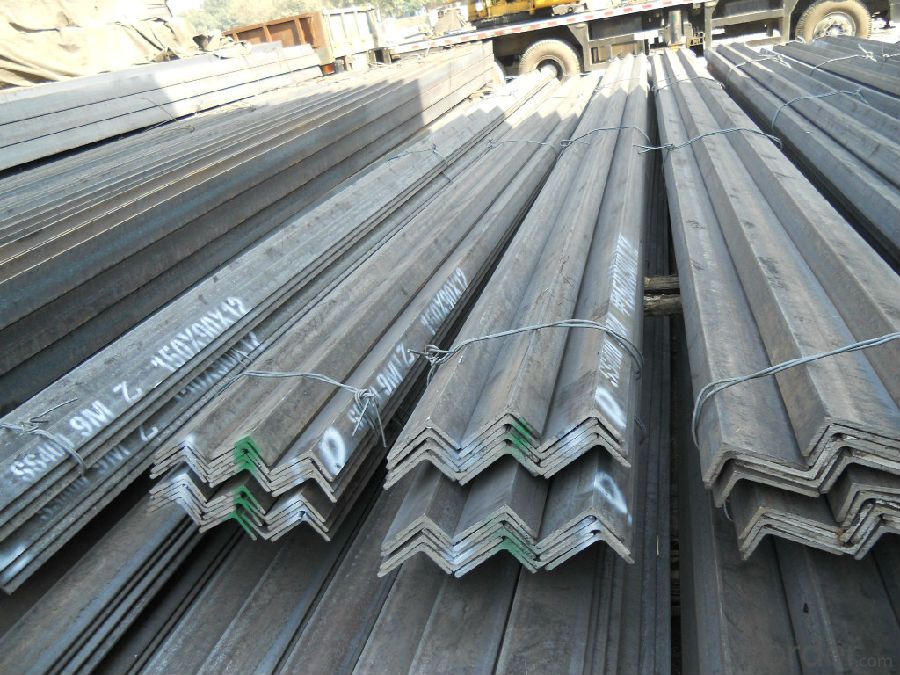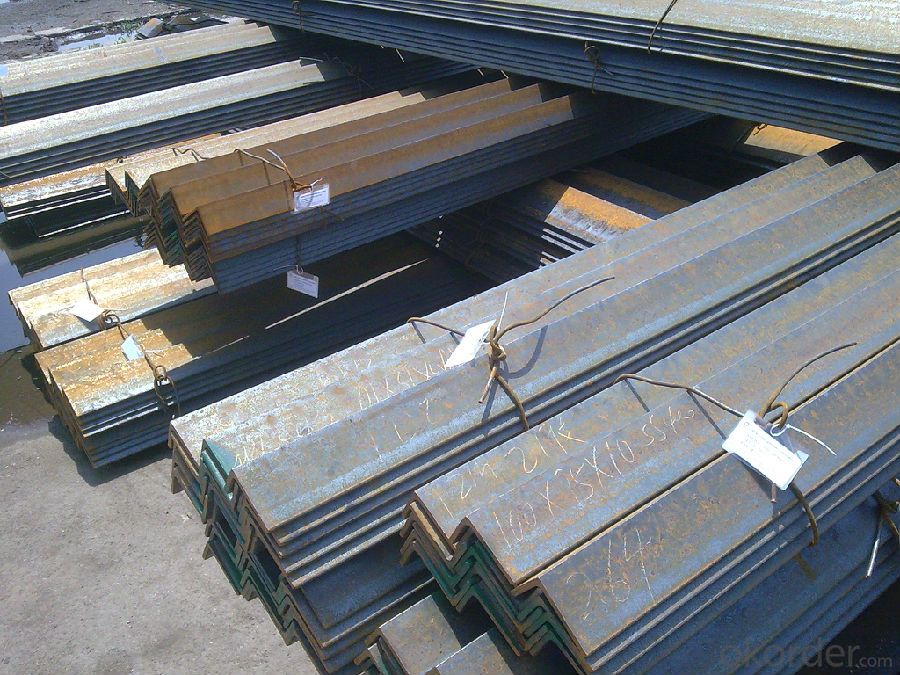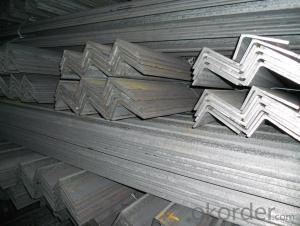Prime HR Unequal Angle Steel For Steel Structure
- Loading Port:
- China main port
- Payment Terms:
- TT OR LC
- Min Order Qty:
- 100 m.t.
- Supply Capability:
- 20000 m.t./month
OKorder Service Pledge
OKorder Financial Service
You Might Also Like
Product Description:
OKorder is offering Prime HR Unequal Angle Steel For Steel Structure at great prices with worldwide shipping. Our supplier is a world-class manufacturer of steel, with our products utilized the world over. OKorder annually supplies products to African, South American and Asian markets. We provide quotations within 24 hours of receiving an inquiry and guarantee competitive prices.
Product Applications:
PrimePrime HR Unequal Angle Steel For Steel Structure are ideal for structural applications and are widely used in the construction of buildings and bridges, and the manufacturing, petrochemical, and transportation industries.
Product Advantages:
OKorder's Prime HR Unequal Angle Steel For Steel Structure are durable, strong, and wide variety of sizes.
Main Product Features:
· Premium quality
· Prompt delivery & seaworthy packing (30 days after receiving deposit)
· Can be recycled and reused
· Mill test certification
· Professional Service
· Competitive pricing
Product Specifications:
Manufacture: Hot rolled
Grade: Q195 – 235
Certificates: ISO, SGS, BV, CIQ
Length: 6m – 12m, as per customer request
Packaging: Export packing, nude packing, bundled
| UNEQUAL ANGLE STEEL | |||||
| size(mm) | a(mm) | a1(mm) | thickness(mm) | kg/m | length(m) |
| 75*50*5 | 75 | 50 | 5 | 4.808 | 6m,9m,12m |
| 75*50*6 | 75 | 50 | 6 | 5.699 | 6m,9m,12m |
| 75*50*8 | 75 | 50 | 8 | 7.431 | 6m,9m,12m |
| 100*75*7 | 100 | 75 | 7 | 9.34 | 6m,9m,12m |
| 100*75*8 | 100 | 75 | 8 | 10.6 | 6m,9m,12m |
| 100*75*9 | 100 | 75 | 9 | 11.8 | 6m,9m,12m |
| 100*75*10 | 100 | 75 | 10 | 13 | 6m,9m,12m |
| 100*75*12 | 100 | 75 | 12 | 15.4 | 6m,9m,12m |
| 125*75*7 | 125 | 75 | 7 | 10.7 | 6m,9m,12m |
| 125*75*8 | 125 | 75 | 8 | 12.2 | 6m,9m,12m |
| 125*75*9 | 125 | 75 | 9 | 13.6 | 6m,9m,12m |
| 125*75*10 | 125 | 75 | 10 | 15 | 6m,9m,12m |
| 125*75*12 | 125 | 75 | 12 | 17.8 | 6m,9m,12m |
| 150*90*8 | 150 | 90 | 8 | 14.7 | 6m,9m,12m |
| 150*90*9 | 150 | 90 | 9 | 16.4 | 6m,9m,12m |
| 150*90*10 | 150 | 90 | 10 | 18.2 | 6m,9m,12m |
| 150*90*12 | 150 | 90 | 12 | 21.6 | 6m,9m,12m |
| 200*100*10 | 200 | 100 | 10 | 23 | 6m,9m,12m |
| 200*100*12 | 200 | 100 | 12 | 27.62 | 6m,9m,12m |
| 200*100*15 | 200 | 100 | 15 | 34.04 | 6m,9m,12m |
FAQ:
Q1: Why buy Materials & Equipment from OKorder.com?
A1: All products offered byOKorder.com are carefully selected from China's most reliable manufacturing enterprises. Through its ISO certifications, OKorder.com adheres to the highest standards and a commitment to supply chain safety and customer satisfaction.
Q2: How soon can we receive the product after purchase?
A2: Within three days of placing an order, we will arrange production. The normal sizes with the normal grade can be produced within one month. The specific shipping date is dependent upon international and government factors, the delivery to international main port about 45-60days.
Q3: How many tons of steel products could be loaded in containers?
A3: Usually the steel products are delivered by bulk vessel because of the large quantity and the freight. However, there are no bulk vessel enter some seaports so that we have to deliver the cargo by containers. The 6m steel product can be loaded in 20FT container, but the quantity is changed according to the size, usually from 18tons to 25tons.
Images:


- Q:What are the different types of steel angles used in transmission line towers?
- Transmission line towers commonly utilize various types of steel angles to provide structural support and stability. These angles are specifically designed to withstand the weight of the transmission lines and the environmental conditions they are exposed to, ensuring the tower's durability. 1. Equal leg angle: This angle features two legs of equal length, forming a right angle. Its simple design and easy fabrication make it a widely used choice in transmission line towers. 2. Unequal leg angle: In this type of angle, the legs have unequal lengths, creating an acute or obtuse angle. Unequal leg angles are employed in transmission line towers that require specific load-bearing capabilities. 3. Bulb angle: Characterized by a bulbous end, bulb angles offer additional strength and stability. They are commonly used in critical areas of transmission line towers, such as the base or connection points, where extra support is needed. 4. Lipped angle: Lipped angles have an extended lip on one side, increasing their load-bearing capacity. They are commonly employed in transmission line towers that require enhanced strength and stability. 5. Back-to-back angle: Back-to-back angles consist of two equal leg angles joined with their flanges touching. This configuration creates a wider angle, providing improved load-bearing capabilities and resistance to bending. It is often selected for transmission line towers that need to support higher loads or longer spans. Each type of steel angle has its own unique characteristics and advantages, allowing engineers to select the most suitable angle for the specific tower design requirements. Careful consideration of these angles ensures the overall strength, stability, and durability of the transmission line tower, facilitating the reliable and efficient transmission of electricity.
- Q:What is the maximum spacing for steel angles in a support structure?
- The maximum spacing for steel angles in a support structure depends on various factors such as the load requirements, material strength, and design specifications. However, it is generally recommended to consult with a structural engineer or refer to relevant building codes and standards to determine the appropriate maximum spacing for steel angles in a specific support structure.
- Q:Are steel angles affected by temperature changes?
- Yes, steel angles are affected by temperature changes. Steel has a coefficient of thermal expansion, meaning it expands when exposed to higher temperatures and contracts when exposed to lower temperatures. These temperature changes can cause the steel angles to expand or contract, potentially leading to dimensional changes and structural stress.
- Q:How do you determine the required angle length for a specific application?
- There are several factors that need to be taken into account when determining the necessary length of an angle for a specific application. Firstly, it is important to identify the purpose of the angle in the application. Will it be used for structural support, bracing, or as a decorative element? This will help determine the level of strength and stability required, which will then influence the length of the angle. Next, it is necessary to assess the load or weight that the angle will need to bear. Understanding the amount of force or pressure that will be applied to the angle will assist in determining the appropriate length. A heavier load may require a longer angle to effectively distribute the weight and prevent bending or failure. The material of the angle is another crucial consideration. Different materials have varying levels of strength and durability. For instance, steel angles are stronger than aluminum angles. The properties of the material, such as tensile strength and resistance to corrosion, will impact the required length for the specific application. Furthermore, the specific geometry and configuration of the application should be taken into account. Factors like the overall dimensions, desired angle of inclination, and any additional supports or attachments must be considered. These factors may affect the length needed to ensure proper fit, function, and stability. Lastly, it is important to consult industry standards and regulations to guarantee compliance and safety. Certain applications may have specific guidelines for the length of angles to be used, particularly in fields like construction or engineering. In conclusion, determining the necessary length of an angle for a specific application requires a comprehensive analysis of the purpose, load, material, geometry, and relevant standards. Seeking advice from experts or engineers in the field can also provide valuable insights and guidance.
- Q:Are steel angles suitable for load-bearing walls in residential buildings?
- Load-bearing walls in residential buildings can indeed be supported by steel angles. The reason for their widespread use in construction is their impressive strength and durability. These angles are capable of withstanding heavy loads and contribute to the stability of the structure. Moreover, steel angles offer the advantage of easy installation and cost-effectiveness compared to alternative building materials. Additionally, they possess fire-resistant properties, a crucial aspect for ensuring the safety of residential buildings. In conclusion, steel angles are a dependable option when it comes to load-bearing walls in residential buildings.
- Q:What is the typical corrosion resistance of steel angles?
- The corrosion resistance of steel angles can vary depending on the grade of steel used and the environmental conditions they are exposed to. Generally, steel angles have a moderate to high level of corrosion resistance because they contain alloying elements like chromium, nickel, and molybdenum. These elements create a protective oxide layer on the steel's surface, preventing further corrosion. Moreover, applying coatings or treatments like galvanization or painting can further enhance the corrosion resistance of steel angles. Ultimately, choosing the right grade of steel angle with the desired corrosion resistance level depends on considering the specific application and environment.
- Q:How do you calculate the second moment of area for a steel angle?
- To calculate the second moment of area for a steel angle, you need to follow a step-by-step process. Here's how you can do it: 1. Begin by drawing the cross-section of the steel angle on a piece of paper or using a CAD software. Make sure to label all the dimensions accurately. 2. Divide the angle into smaller geometric shapes, such as rectangles and triangles, which are easier to calculate the second moment of area for. 3. Calculate the individual second moments of area for each geometric shape. The formula for the second moment of area, also known as the moment of inertia, varies depending on the shape. For rectangles, the formula is (b * h^3) / 12, where b is the base and h is the height. For triangles, the formula is (b * h^3) / 36, where b is the base and h is the height. Adjust the formulas based on the orientation and position of the shapes within the angle. 4. Sum up the individual second moments of area for all the shapes within the angle. If there are any holes or cutouts in the angle, subtract their second moments of area from the total. 5. Once you have calculated the second moments of area for all the shapes and accounted for any cutouts, add them up to obtain the total second moment of area for the steel angle. It's important to note that the second moment of area represents the resistance of a cross-section to bending. It is a crucial parameter in structural analysis and design, as it helps determine the strength and stability of a member under loads.
- Q:Can steel angles be used for machine guards?
- Yes, steel angles can be used for machine guards. Steel angles are commonly used in the construction industry for their strength and durability. They can be easily fabricated and installed to create a protective barrier around machinery, ensuring the safety of workers and preventing accidents. The versatility of steel angles allows them to be customized to fit various machine sizes and shapes. Additionally, steel angles offer good impact resistance and can withstand heavy loads, making them suitable for use in machine guarding applications.
- Q:Can steel angles be used in mining or offshore applications?
- Yes, steel angles can be used in mining or offshore applications. They are commonly used in these industries due to their high strength, durability, and corrosion resistance properties. Steel angles are versatile and can be utilized for various purposes such as structural support, framing, and bracing in mining operations or offshore structures.
- Q:What are the different types of steel angle profiles?
- There are several different types of steel angle profiles, including equal angle, unequal angle, L-shaped angle, and structural angle. Each profile has its own specific dimensions and uses in various applications.
1. Manufacturer Overview |
|
|---|---|
| Location | |
| Year Established | |
| Annual Output Value | |
| Main Markets | |
| Company Certifications | |
2. Manufacturer Certificates |
|
|---|---|
| a) Certification Name | |
| Range | |
| Reference | |
| Validity Period | |
3. Manufacturer Capability |
|
|---|---|
| a)Trade Capacity | |
| Nearest Port | |
| Export Percentage | |
| No.of Employees in Trade Department | |
| Language Spoken: | |
| b)Factory Information | |
| Factory Size: | |
| No. of Production Lines | |
| Contract Manufacturing | |
| Product Price Range | |
Send your message to us
Prime HR Unequal Angle Steel For Steel Structure
- Loading Port:
- China main port
- Payment Terms:
- TT OR LC
- Min Order Qty:
- 100 m.t.
- Supply Capability:
- 20000 m.t./month
OKorder Service Pledge
OKorder Financial Service
Similar products
New products
Hot products
Related keywords




























